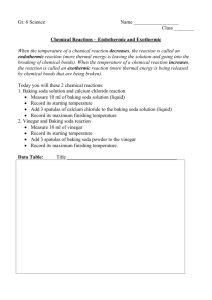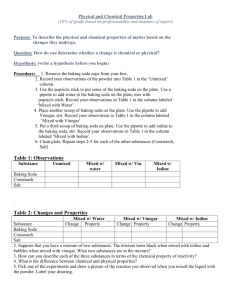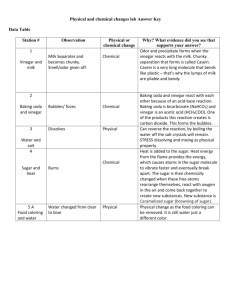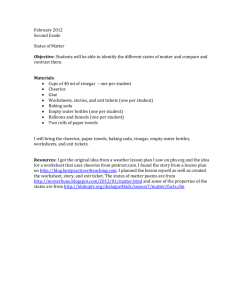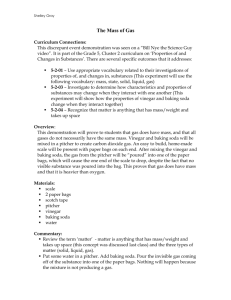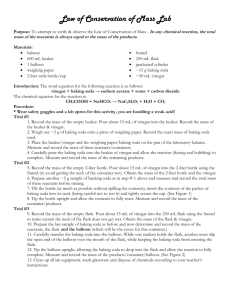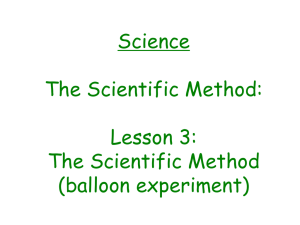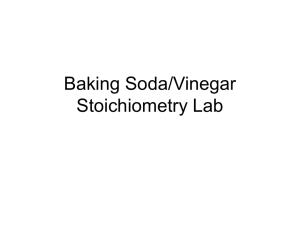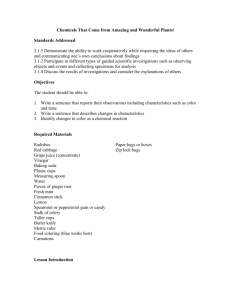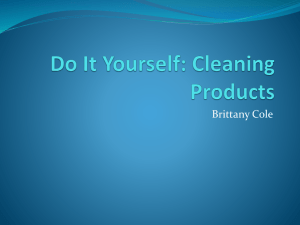Chemical Changes
advertisement
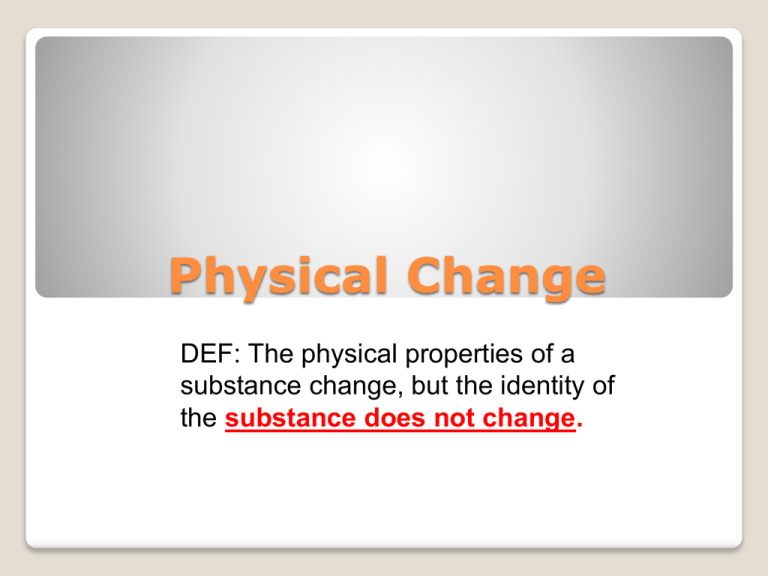
Physical Change DEF: The physical properties of a substance change, but the identity of the substance does not change. Examples of Physical Changes States of matter (solid, liquid, gas): ice H2O steam Although water is in the form of ice it still has the same chemical composition (H2O) Examples of Physical Changes Tearing a piece of paper Chopping wood Glass Breaking Examples of Physical Changes Mixtures: Adding red food coloring to water Sugar and salt dissolve in water Chemical Change DEF: A chemical change is when matter has changed into a new substance through a chemical reaction. What is a chemical change? The animation to the right shows a chemical change. The blue and white molecule is more attracted to the red and white atoms than the green atom so they switch, forming a new substance. Animation from: http://www.ias.ac.in/initiat/sci_ed/resources/chemistry/sn2.gif Why did baking soda and vinegar bubble? A chemical change occurrs when you combine baking soda and vinegar. ◦ Vinegar makes the water more acidic. ◦ When the molecules in baking soda mix with the acid, some of their atoms are more attracted to the acid and they break apart to form new molecules. Baking Soda Baking soda and vinegar are like two couples dancing. When they are separate from each other they stay with their own molecule… Vinegar Why did baking soda and vinegar bubble? A chemical change occurred when you combined baking soda and vinegar. ◦ Vinegar makes the water more acidic. ◦ When the molecules in baking soda mix with the acid, some of their atoms are more attracted to the acid and they break apart to form new molecules. Baking Soda Vinegar But when the two molecules mix, atoms from one molecule are more attracted to the other molecule… Why did baking soda and vinegar bubble? A chemical change occurrs when you combine baking soda and vinegar. ◦ Vinegar makes the water more acidic. ◦ When the molecules in baking soda mix with the acid, some of their atoms are more attracted to the acid and they break apart to form new molecules. Sodium, and other stuff CO2 H2O …So they switch dance partners and form new substances. Notice that nothing was created or destroyed… just changed. Evidence for a Chemical Change 1. Formation of a gas Evidence for a Chemical Change 2. Color Change ◦ Seeing a color change after mixing substances together is evidence that a chemical change took place. From: http://www.youtube.com/watch?v=yqUghaS5apk Why did red cabbage juice turn the powders different colors? A chemical change occurred when red cabbage juice was added to cream of tartar and laundry detergent. ◦ Red cabbage juice is an indicator, because it contains molecules that change color when an acid or base is added to them. ◦ Cream of tartar is an acid, so it gave particles to the indicator, making it turn from blue to pink. ◦ Laundry detergent is a base, so it took particles from the indicator, making it turn from pink back to blue. Evidence for a Chemical Change 3. Temperature Change Evidence for a Chemical Change Formation of a Precipitate 4. When mixing two substances together a new solid forms. This is called a precipitate. Iron + Oxygen = Rust Is it a Chemical Change? Write down “YES” on your paper if it is a chemical change, and “NO” if it isn’t. If YES, list what evidence supports this. (Example: gas formation). Is it a Chemical Change? A forest fire destroys acres of land. There is a lot of smoke, and the trees turn to charcoal. ANSWER: EVIDENCE: YES - Smoke, - color change, - temperature change Is it a Chemical Change? When making hot cocoa, clear water turns brown when you mix the cocoa in. ANSWER: No (the water is turning brown because the cocoa is brown) Is it a Chemical Change? An old wheelbarrow is left out in the rain and rusts. ANSWER: Yes EVIDENCE: Color change, precipitate forming (rust) Is it a Chemical Change? On a hot day, water forms on the outside of a cold glass of water. ANSWER: No (No new substance is forming) Is it a Chemical Change? Ice cream melts after it falls on the ground. ANSWER: No (No new substance is forming) Is it a Chemical Change? A raw egg gets cooked. ANSWER: Yes EVIDENCE: Color change Is it a Chemical Change? When Alka Seltzer is dropped into water it fizzes. ANSWER: Yes EVIDENCE: gas formation Is it a Chemical Change? Crayons change white paper to red. ANSWER: No (The paper is turning red because the crayon is red.) Is it a Chemical Change? Soda fizzes, and bubbles rise as you pour it in a glass. ANSWER: No (The bubbles were already there, just under pressure in the bottle.) Is it a Chemical Change? When you crack a glow stick, hydrogen peroxide mix with other chemicals, causing it to glow and warm up. ANSWER: EVIDENCE: Yes - color change - temperature change

